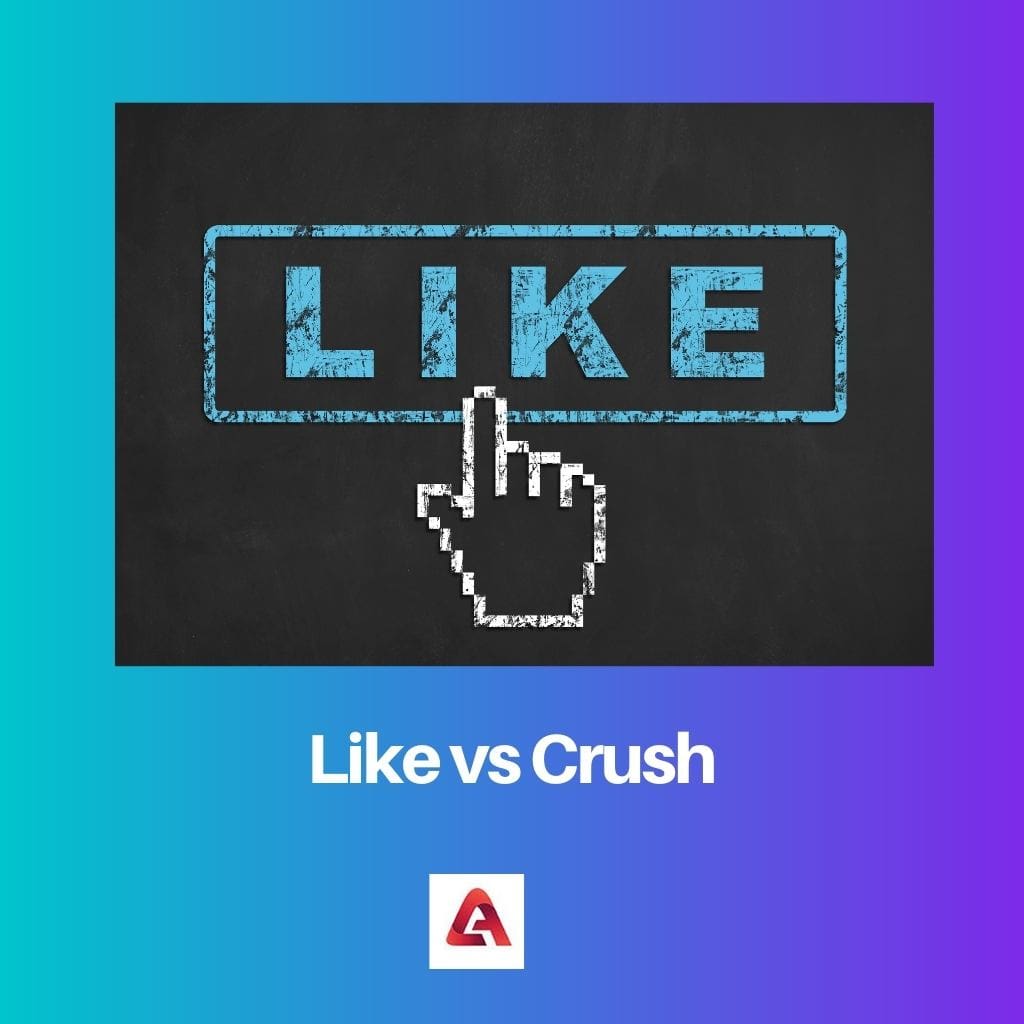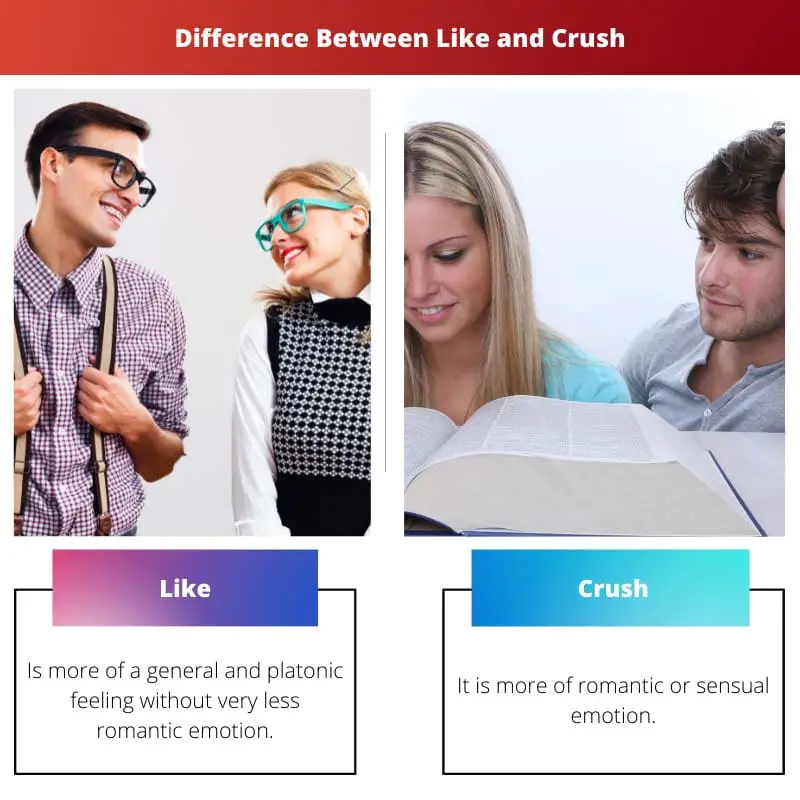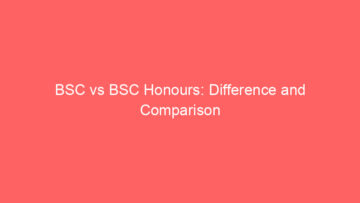A “like” is a pleasant admiration, a recognition of positive qualities that draws you towards someone. It’s a surface-level attraction based on appreciation. A “crush” goes beyond liking; it’s an intense and romantic infatuation. It involves a deep emotional connection and a desire for more profound involvement in that person’s life.
Key Takeaways
- “Like” is a positive feeling towards someone, while a “crush” is a temporary, intense attraction to someone.
- “Like” is based on a deeper understanding of a person, while a “crush” is based on physical or superficial qualities.
- “Like” can develop into a long-lasting friendship or romantic relationship, while a “crush” may fade or become more serious.
Like vs Crush
“Like” denotes a positive feeling toward someone, and “Like” can be platonic or romantic. Crush” denotes a stronger and more intense romantic attraction.

Comparison Table
| Feature | Like | Crush |
|---|---|---|
| Intensity of Feeling | Milder, more casual | Stronger, more passionate |
| Focus | Appreciation of personal qualities, shared interests, or physical attractiveness | Strong attraction and potential for romantic feelings |
| Duration | Can be fleeting or long-lasting | Typically shorter than a full-blown relationship, can fade over time |
| Desire for Intimacy | Minimal to none | May yearn for closer emotional or physical connection |
| Behavior | Friendly, courteous interaction | Increased attention, desire to spend more time together, possible shyness or nervousness |
| Action | May enjoy spending time together in a group setting, casually interacting | May attempt to impress the other person, initiate more personal interaction, seek private moments together |
What is a Liking?
Liking refers to a positive emotional response or preference towards someone or something. It is a subjective experience that involves feelings of warmth, affection, or approval. This concept is deeply rooted in psychology and plays a significant role in human relationships, social interactions, and decision-making processes.
Factors Influencing Liking
1. Similarity:
- People tend to like others who share common interests, values, or characteristics.
- Similarity creates a sense of connection and understanding, fostering positive feelings.
2. Proximity:
- Physical or psychological closeness can enhance liking.
- Regular exposure to individuals increases the likelihood of developing positive feelings towards them.
3. Reciprocity:
- The principle of reciprocity suggests that individuals feel compelled to return favors or positive actions.
- Acts of kindness or generosity lead to increased liking between individuals.
4. Physical Attractiveness:
- Studies show that physical attractiveness can significantly influence liking.
- People tend to be drawn to those perceived as physically appealing.
5. Positive Experiences:
- Shared positive experiences create bonds and contribute to the development of liking.
- Memories of enjoyable times together strengthen the emotional connection.
The Role of Liking in Relationships
1. Formation of Relationships:
- Liking is a crucial factor in the initial stages of relationship formation.
- Positive feelings lay the foundation for deeper connections and attachments.
2. Maintenance of Relationships:
- Liking plays a vital role in sustaining relationships over time.
- It contributes to the resilience of relationships during challenging periods.
3. Impact on Communication:
- Positive liking facilitates open and effective communication.
- Individuals are more likely to express themselves honestly in a liked and supportive environment.
Liking in Decision-Making
1. Consumer Behavior:
- Liking influences consumer choices and brand preferences.
- Positive feelings towards a product or brand contribute to customer loyalty.
2. Professional Relationships:
- Liking is crucial in the workplace for team dynamics and collaboration.
- Positive interpersonal relationships enhance productivity and job satisfaction.

What is a Crush?
In the realm of human emotions, a “crush” is a complex and intriguing phenomenon that defies straightforward definition. It is commonly used to describe a powerful and fleeting infatuation or attraction towards another person. The term is deeply rooted in the realm of romantic feelings, but its scope can extend beyond mere romantic interest. Let’s delve into the details to gain a comprehensive understanding of this captivating concept.
Characteristics of a Crush
1. Intensity
A crush is characterized by an intense and overwhelming emotional response. Individuals experiencing a crush may find themselves captivated by the object of their affection, leading to heightened emotions such as excitement, nervousness, and a sense of euphoria.
2. Short-lived Nature
Crushes are transient in nature. Unlike long-term romantic feelings or love, a crush tends to be short-lived, lasting anywhere from a few days to several months. It represents an initial stage of romantic interest before evolving into a deeper connection or fading away.
3. Idealization
During a crush, individuals may idealize the person they are attracted to. This involves attributing exceptional qualities to the crush, sometimes without a thorough understanding of their true personality. Idealization contributes to the intense and romanticized nature of the emotions involved.
4. Limited Interaction
Crushes may be based on limited interaction with the person of interest. In many cases, the individual harboring the crush may not have a deep or meaningful connection with the crush, leading to a sense of mystery and excitement surrounding the person.
Psychological Insights
1. Neurotransmitter Release
The experience of a crush is linked to the release of neurotransmitters such as dopamine and serotonin in the brain. These chemicals contribute to the euphoric feelings associated with attraction and infatuation, creating a sense of pleasure and reward.
2. Emotional Learning
Crushes play a role in emotional learning and development. They offer individuals the opportunity to navigate and understand their emotions, preferences, and desires in the context of romantic attraction. This process contributes to personal growth and self-discovery.

Main Differences Between Like and Crush
- Definition:
- Like:
- Generally refers to a positive feeling or preference towards someone or something.
- Crush:
- Involves a more intense and romantic attraction towards someone.
- Like:
- Intensity:
- Like:
- Can be a casual or friendly admiration.
- Crush:
- Involves a deeper and more emotional connection.
- Like:
- Emotional Involvement:
- Like:
- May not necessarily involve strong emotions.
- Crush:
- Often associated with butterflies, excitement, and a heightened emotional state.
- Like:
- Duration:
- Like:
- Can be temporary or fleeting.
- Crush:
- Tends to be more persistent and may develop into a long-term attraction.
- Like:
- Nature:
- Like:
- Can be platonic or romantic.
- Crush:
- Usually has a romantic or infatuation element to it.
- Like:
- Mutuality:
- Like:
- Can be one-sided without a mutual feeling from the other person.
- Crush:
- Often involves a desire for reciprocation and mutual attraction.
- Like:
- Expression:
- Like:
- Expressed through friendly gestures or positive comments.
- Crush:
- May involve more subtle or indirect expressions of affection, sometimes due to fear of rejection.
- Like:
- Development:
- Like:
- Can develop from admiration or appreciation.
- Crush:
- Often develops from a combination of physical attraction and emotional connection.
- Like:
- Impact on Behavior:
- Like:
- Might not significantly influence behavior.
- Crush:
- Can lead to changes in behavior, such as nervousness or self-consciousness around the person.
- Like:
- Depth of Connection:
- Like:
- May not necessarily lead to a deep emotional connection.
- Crush:
- Often involves a desire for a deeper emotional or romantic connection.
- Like:
- Handling Rejection:
- Like:
- Rejection may not be as emotionally challenging.
- Crush:
- Rejection can be more emotionally impactful and may take longer to move on from.
- Like:







